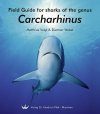About this book
Language: English
All known and relevant data and features to enable an identification of sharks of the genus Carcharhinus (BLAINVILLE 1816) are summarised and visualised in this book. The introduced species are difficult to separate for somebody who is not experienced in identifying sharks. An identification key is given to determine and to differentiate the species. For each species an extended list of characters is given including coloured figures to show the lateral and ventral view, a detailed view of nostril and teeth, and in some cases of juveniles and special characters. Further, data on body size and appearance, colouration, tooth formula and shape, numbers of vertebrae, on other internal and external characters, the geographical distribution, preferred habitat and food spectrum are presented. In addition, biological and reproductional data are included, e. g. number of young per litter, size at birth, size at sexual maturity, as well as behaviour and migrational patterns.
Most of the previous works about Carcharhinus listed and discussed a maximum of 30 species. In contrast, this field guide describes 33 species, six species with special notes of the authors. Further, a possible subdivision of the spinner shark, C. brevipinna, in an Atlantic and Pacific subspecies is briefly discussed. An almost unknown species, C. acarenatus, formerly considered a synonym of C. brachyurus, is introduced. A very rare species, C. leiodon, which was hitherto recorded only once by GARRICK (1985), is included and controversially discussed. Another species in dispute, Carcharhinus sp. A, mentioned by COMPAGNO et al. (2005) as new member of the genus, is comprised and discussed.
Contents
Foreword#
Preface#
Acknowledgments#
Introduction#
Aims of this book
Evolution of sharks - fossil records
Taxonomic classification of sharks
Short introduction to general biology and anatomy of sharks (genus Carcharhinus)
Morphology
Senses
Teeth
Buoyancy and breathing
Reproduction
Distribution and behaviour
Sexual dimorphism
Preparation of this book
Materials and Methods#
Key to species
Systematic arrangement
Generic synonyms
Examination of specimens
Species characterisations
Coloured figures of species
Species synonyms
Diagnostic features
Dental formula and tooth morphology
Colouration
Size
Misidentifications
Geographical Distribution
Habitat preference
General biological issues
Reproductive Biology
Food spectrum
Red list status
Tables and Graphs
Detailed photographs of dentition
Measurements#
Technical terms#
Key to genera and species#
Key to genera
Key to species of the genus Carcharhinus
Species characterisations#
Carcharhinus acarenatus
Carcharhinus acronotus
Carcharhinus albimarginatus
Carcharhinus altimus
Carcharhinus amblyrhynchoides
Carcharhinus amblyrhynchos
Carcharhinus amboinensis
Carcharhinus borneensis
Carcharhinus brachyurus
Carcharhinus brevipinna
Carcharhinus cautus
Carcharhinus dussumieri
Carcharhinus falciformis
Carcharhinus fitzroyensis
Carcharhinus galapagensis
Carcharhinus hemiodon
Carcharhinus isodon
Carcharhinus leiodon
Carcharhinus leucas
Carcharhinus limbatus
Carcharhinus longimanus
Carcharhinus macloti
Carcharhinus melanopterus
Carcharhinus obscurus
Carcharhinus perezii
Carcharhinus plumbeus
Carcharhinus porosus
Carcharhinus sealei
Carcharhinus signatus
Carcharhinus sorrah
Carcharhinus tilstoni
Carcharhinus wheeleri
Species in question#
Carcharhinus sp. A.
Tables#
Graphs#
Detailed photographs of dentition#
Abbreviations#
Bibliography#
Index of Scientific and Vernacular Names#
Customer Reviews
Biography
Dr. Matthias VOIGT studied marine biology at the University of Rostock (2000-2004) where he examined the impact of climate change on growth of Antarctic invertebrates. After receiving his PhD from the University of Karlsruhe, Department of Technical Biology, where he studied the biotechnological cultivation of Mediterranean sponges under artificial culture conditions, he moved 2010 to the University of Konstanz, where he works in the Department of Biology, Human & Environmental Toxicology Group.
During many dives he made several experiences with sharks in the field, and was fascinated by these majestic creatures. Since 2001 he is member of the German Elasmobranch Society (D.E.G.), and he tries to impart his experience, knowledge and fascination of sharks to public for a better understanding and increasing protection of this group of animals.
Dietmar WEBER has graduated a professional training as Technician for Biology i. e. Ecology (1988) and is employee at the Research Institute for Forest Ecology and Forestry of Rhineland-Palatinate in Trippstadt (since 1989).
Since his early childhood he showed a strong interest in nature and animals as well, with the main focus in fish. His passion is detailed and lifelike portraying of animals which he has improved to perfection in the last forty years. At the moment his dedication is focused on sharks, skates and rays, and he is member of the German Elasmobranch Society since 1999. He delivered many coloured plates and figures for several article publications, books, homepages and calendars.


























![Lo Squalo Bianco nei Mari d'Italia [The White Shark in the Seas of Italy]](http://mediacdn.nhbs.com/jackets/jackets_resizer_medium/17/178659.jpg?height=150&width=96)
![Guia de Identificación de las Mantas y Rayas Diablo del Mundo [Field Guide to Manta & Devil Rays of the World]](http://mediacdn.nhbs.com/jackets/jackets_resizer_medium/26/268159.jpg?height=150&width=212)











